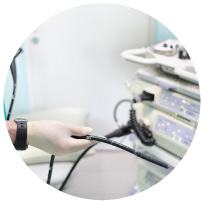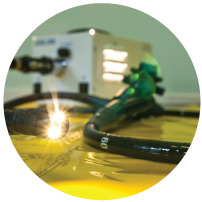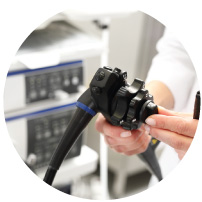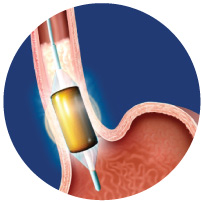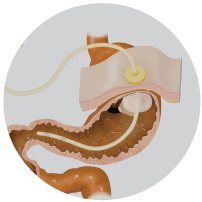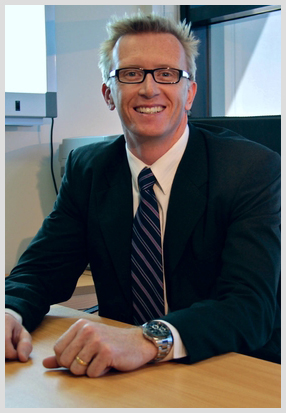
Please follow the links on the patient information page to discover more about the services offered.
RADIOFREQUENCY ABLATION (HALO)
Commonly asked questions
What is Barrett’s Oesophagus?
Barrett’s oesophagus is a change in the cell lining of the oesophagus secondary to chronic reflux and acid exposure. The normal squamous cell lining alters to become columnar cells with intestinal metaplasia. The reason this is important is that it increases the risk of developing cancer. There are different levels of disease progression with Barrett’s called dysplasia. If you do not have any dysplasia then the risk of developing cancer is ~0.5% per year. If you have low – grade dysplasia the risk only increases marginally to ~0.6% per year. In both of these cases we tend to do surveillance endoscopies to ensure the condition does not progress. If you have high – grade dysplasia, the risk of cancer progression is more substantial, ~5% per year. Though a relatively uncommon cancer, this equates to atleast a 44 to more than 220 times increased risk of developing esophageal adenocarcinoma per year compared to the general population. It is therefore recommended that if you have evidence of high – grade dysplasia you should have this treated.
What is squamous cell cancer insitu?
Squamous cell cancer insitu are the very early stages of the development of squamous cell cancer. This is most commonly associated with smoking.
What do I need to do to prepare for the procedure?
You may be required to stop certain medications prior to the procedure. If you are on “blood thinners” such as Warfarin, Clopidogrel (Plavix, Iscover), Dabigatran (Pradaxa), Ticagrelor (Brilinta), you may need to stop these 5 – 7 days prior to your procedure. Aspirin may be continued. Please seek advice prior to stopping these medications. If you are diabetic, you may require special instructions for your medication, especially if you take Insulin. Otherwise, continue all other tablets as usual, even on the day of the test. You may have solid food up to 6 hours prior to your procedure. Then clear fluids only (i.e. water, apple juice, Gatorade) up until 2 hours before the procedure admission time.
How long does the RFA procedure take?
The procedure itself is quite short, and may take anywhere from 30–60 minutes to perform.
How much will it hurt during and after the RFA procedure?
You will be sedated during the procedure. You may experience chest discomfort, sore throat and/or painful or difficult swallowing after the procedure, which are managed with medications. These symptoms typically resolve within 3-4 days.
What medications will I take before and after the procedure?
- Anti-reflux medication, ie. Nexium, Somac, etc.
- Xylocaine viscous 20mg/ml (200ml bottle) – 10-15ml swallowed every 3 hours as needed.
- Paracetamol/Panadeine forte
What and when can I eat after the procedure?
I will normally instruct you to only have a cold clear liquid diet (avoid hot liquids) for the first 24 hours and then a soft diet only for 1 week before returning to a regular diet.
How long will it take me to recover from the procedure?
RFA can be performed as an outpatient procedure or admission for observation over night can be arranged. Immediately after the procedure, you will spend some time resting in recovery while the sedation medications wear off. Recovery time is variable in the days after the RFA procedure, with most patients reporting mild discomfort lasting two to four days. Most patients are able to work and perform their normal daily activities during this time.
What complications might occur?
- A narrowing of the esophagus, referred to as a stricture. Strictures can cause difficulty with swallowing and may need to be treated with additional endoscopic procedures.
- Bleeding which may or may not require treatment.
- Perforation of the stomach, esophagus, or pharynx which may require surgical repair.
How many treatment sessions will I need and over what time frame?
Most patients need an average of 2 to 3 treatment sessions to achieve eradication of their disease. Treatment sessions are usually performed every two to three months until there is no more visible lesions. l then take biopsy samples of your oesophagus, similar to previous surveillance endoscopies to ensure there is no further residual disease.
What are the eradication rates? How often does Barrett’s esophagus come back after treatment?
Will I still need to undergo endoscopy (EGD) with biopsy surveillance after undergoing RFA therapy?
MAKE AN APPOINTMENT
Or visit our clinic at Gold Coast Private Hospital, Suite 8, Ground Floor, 14 Hill Street, Southport QLD 4215
OUR SERVICES
Address
Gold Coast Private Hospital
Suite 8, Ground Floor
14 Hill Street, Southport QLD 4215
Parking stations are accessed from Innovation Drive (off Parklands Drive). There are additionally 20 minute drop-off zones for your convenience. For more information on parking and transport options, please
click here.
Contact Details



